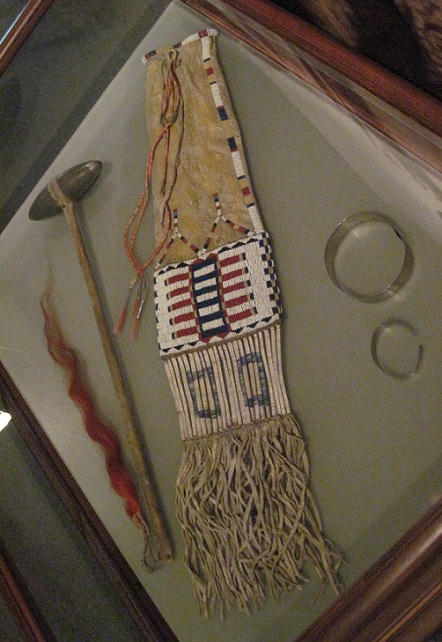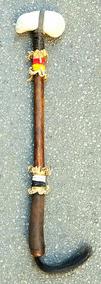Subject: wic'âša 'shirt wearer' warrior
Culture: Lakota Sioux
Setting: Plains Wars, northern Great Plains 1862-1890
Object: skullcracker club
National Museum of Crime and Punishment > A Notorious History of American Crime *
"TWO PLAINS WAR CLUBS
Top Plains war club with a 3" polished granite head attached to a 22" haft with a rawhide band.
The haft is covered with horsehide that ends in an 8" fringe. Beadwork has been added around the base of the head and the end of the haft.
Bottom Stone head war club (1880) was a highly effective weapon in hand-to-hand combat.
The long wood handle is wrapped with buffalo rawhide, painted with vermillion pigment and surmounted by a biconical stone head."
Peabody Museum of Archaeology and Ethnology > Wiyohpiyata - Lakota Images of the Contested West *
"LAKOTA STONE WAR CLUB Inyan, the rock spirit, is the oldest immortal and the grandfather of all things.
Blue is the color of Skan, the Sky and the spiritual energy of the universe."
*
Peabody Museum of Archaeology and Ethnology > Wiyohpiyata - Lakota Images of the Contested West *
"TATANKA-IYOTANKA SITTING BULL Hunkpapa Lakota, 1831-1890 According to the Cheyenne Wooden Leg,
Sitting Bull was recognized as 'the one old man chief of the combined tribes' who fought Custer on the Little Big Horn
in a battle that made him famous around the world. But while he won many war honors,
Sitting Bull was respected primarily as a visionary and holy man (wicasa wakan) who lived by the virtues of generosity,
kindness, and humility. Along with others who refused to submit to reservation life,
he sought refuge in Canada after the Little Big Horn battle. His love for his people, their lands,
and their way of life, and his determination to protect them all inspired many to follow him and keeps his name alive today.
The painted and beaded tobacco bag was collected by Major James McLaughlin of the Standing Rock Agency,
Sitting Bull's home after he and his family surrendered to federal authorities in 1880."

